Japanese bedroom design is the perfect blend of simplicity, nature, and functionality, creating spaces that feel both calming and deeply connected to the environment. With roots in centuries-old traditions, these designs emphasize minimalism without sacrificing warmth or comfort. Elements like tatami mats, shoji screens, and natural wood details contribute to the serene atmosphere that defines Japanese bedrooms. By focusing on harmony and balance, each element works together to transform your space into a peaceful retreat. Whether you’re drawn to low-profile furniture or organic materials, the essence of these 30 cool Japanese-style bedroom design ideas lies in its ability to create a sanctuary for rest and relaxation.

1. Embrace Minimalism with Tatami Mats
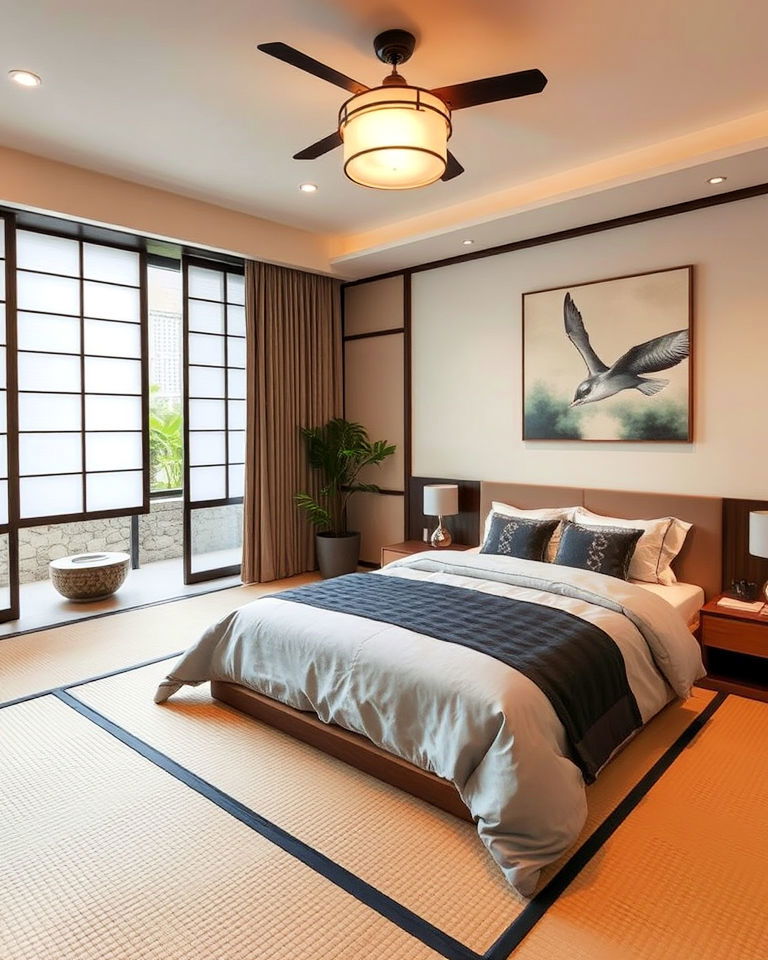
Tatami mats create a serene foundation for any Japanese-style bedroom. Made from rice straw, these mats offer a soft and natural feel underfoot while emphasizing minimalist aesthetics. Placing the futon directly on the tatami encourages a clutter-free environment and fosters relaxation. Their neutral tones pair well with simple wooden furniture and low-profile pieces, reinforcing a calm atmosphere that defines traditional Japanese interiors.
2. Incorporate Shoji Screens for Subtle Light
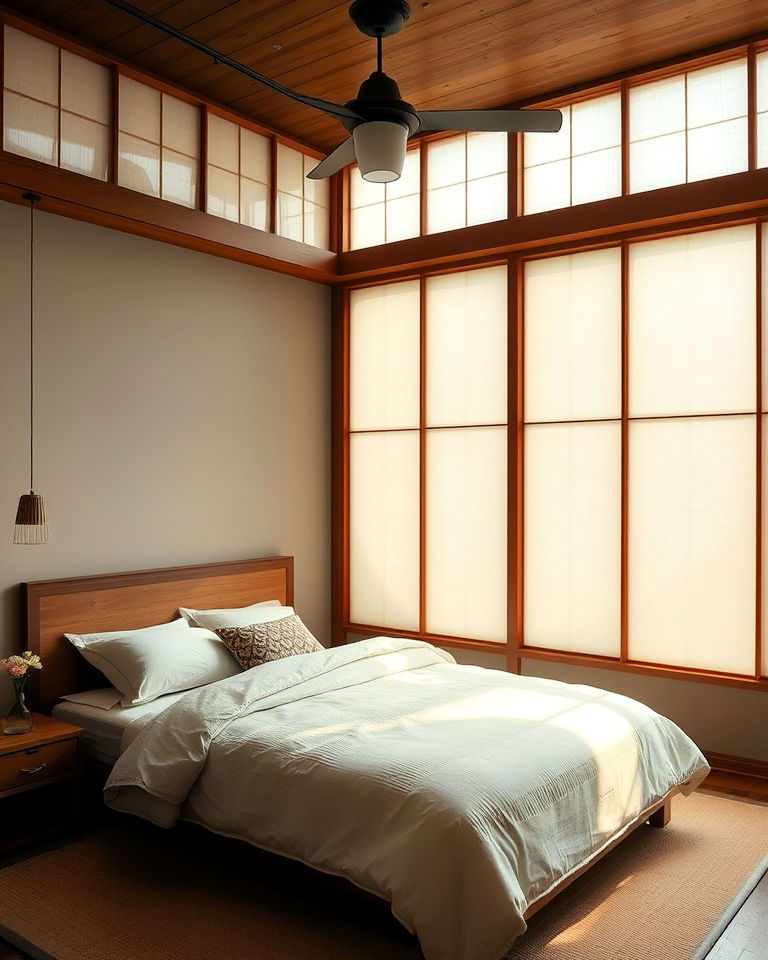
Shoji screens, made from wooden frames and translucent rice paper, allow soft, diffused light to filter into the bedroom. This element not only adds privacy but also enhances the room's tranquility by letting in a gentle glow. Their sliding design saves space, aligning with the minimalist principles often found in Japanese homes. Using shoji screens as room dividers or closet doors brings an authentic touch to your bedroom.
3. Opt for Low Furniture to Ground the Space
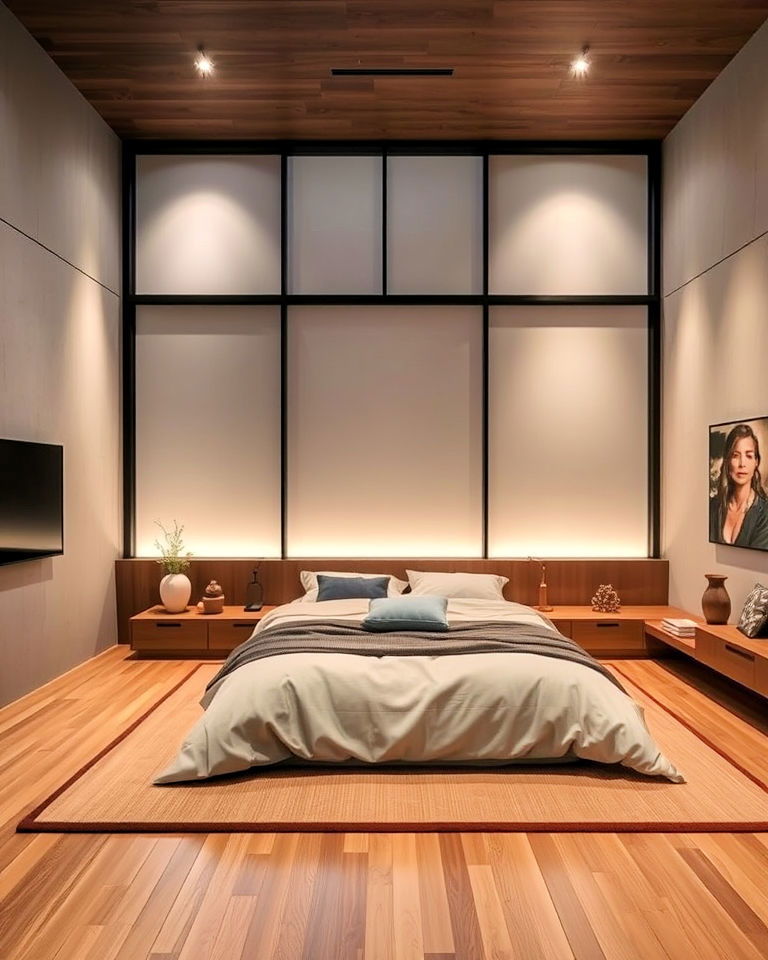
Embrace tranquility with Japanese-style bedroom ideas that blend minimalism and harmony. Japanese design emphasizes a close connection to nature, and low furniture is key to this aesthetic. A low platform bed or futon gives a sense of grounding, encouraging a peaceful and intimate atmosphere. Complementing the low furniture with floor cushions or a low-profile tea table adds to the space's authenticity and simplicity, reinforcing the room's connection to the earth.
4. Add Natural Wood Accents for Warmth
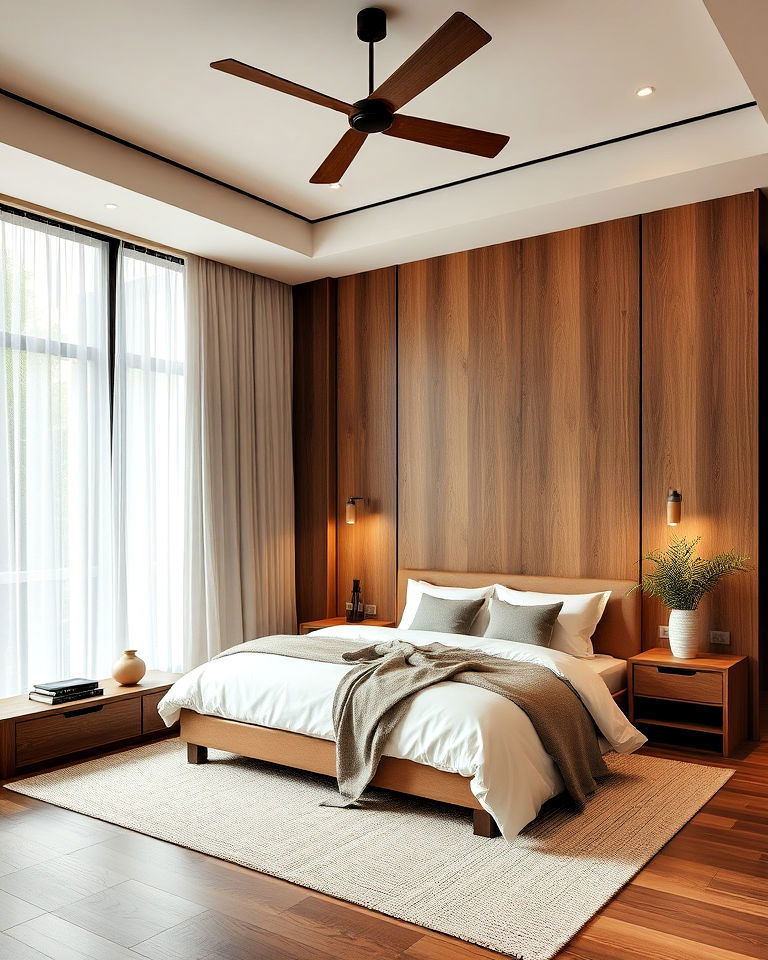
Incorporating natural wood elements, such as a headboard, bedside table, or shelving, adds warmth and texture to a Japanese-inspired bedroom. Woods like cedar, bamboo, and oak are commonly used to balance the minimalist aesthetic with an organic feel. The natural grains and tones of wood create a cozy atmosphere while maintaining the understated elegance typical of Japanese interiors.
5. Create Balance with Symmetry
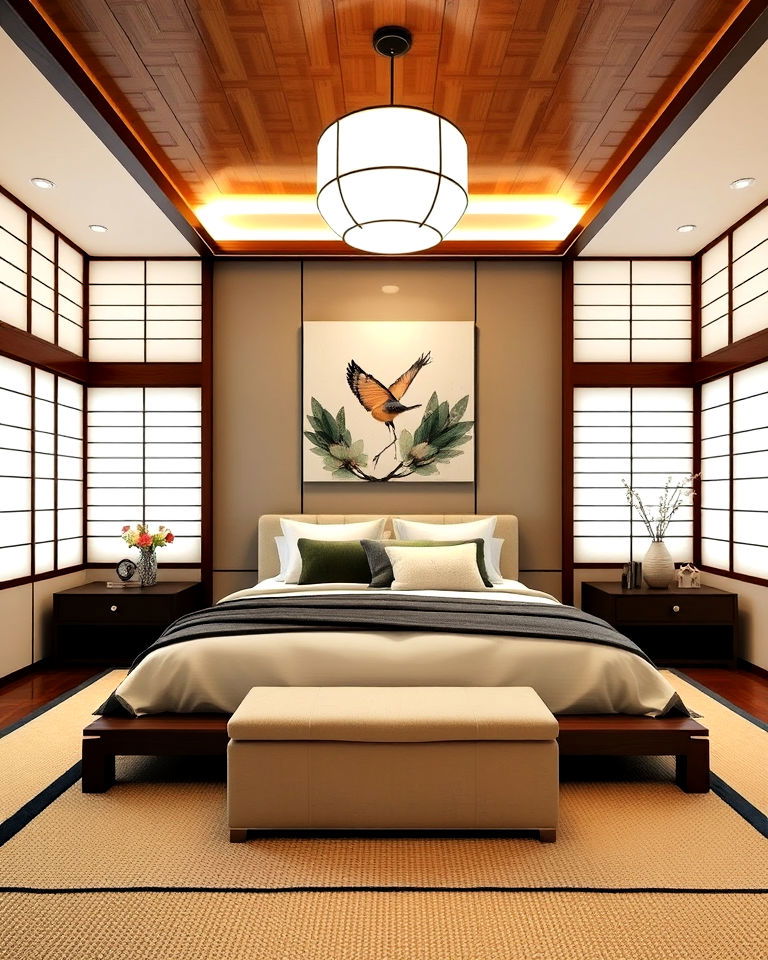
Symmetry is a key principle in Japanese design, contributing to a harmonious and balanced environment. Pairing identical bedside tables, lamps, or artwork on either side of the bed creates a visually pleasing layout. This balance promotes a sense of order and calm, essential to the Japanese philosophy of creating peaceful, uncluttered spaces.
6. Use Neutral Color Palettes

Neutral color schemes are at the heart of Japanese bedroom design, evoking tranquility and simplicity. Soft shades of white, beige, and gray dominate, with natural materials like wood and stone adding texture. These muted tones encourage relaxation and focus, creating a peaceful sanctuary. Occasionally, darker accents in deep browns or blacks can be introduced to provide contrast and depth.
7. Incorporate Sliding Doors for Space Efficiency
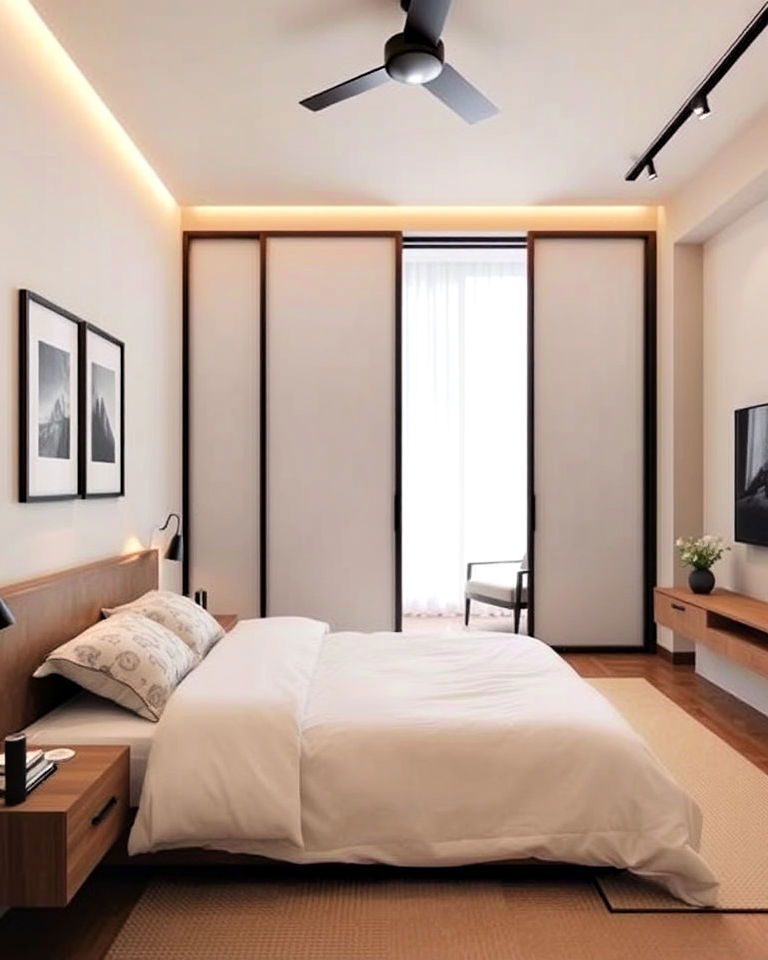
Sliding doors, known as fusuma, are common in Japanese homes and offer a space-saving alternative to traditional doors. These panels can be used to separate the bedroom from other areas, such as a dressing room or en suite. Fusuma also serve as a canvas for artwork, often featuring nature-inspired patterns or muted, elegant designs, adding an artistic touch to the room.
8. Introduce Indoor Plants for a Zen Touch
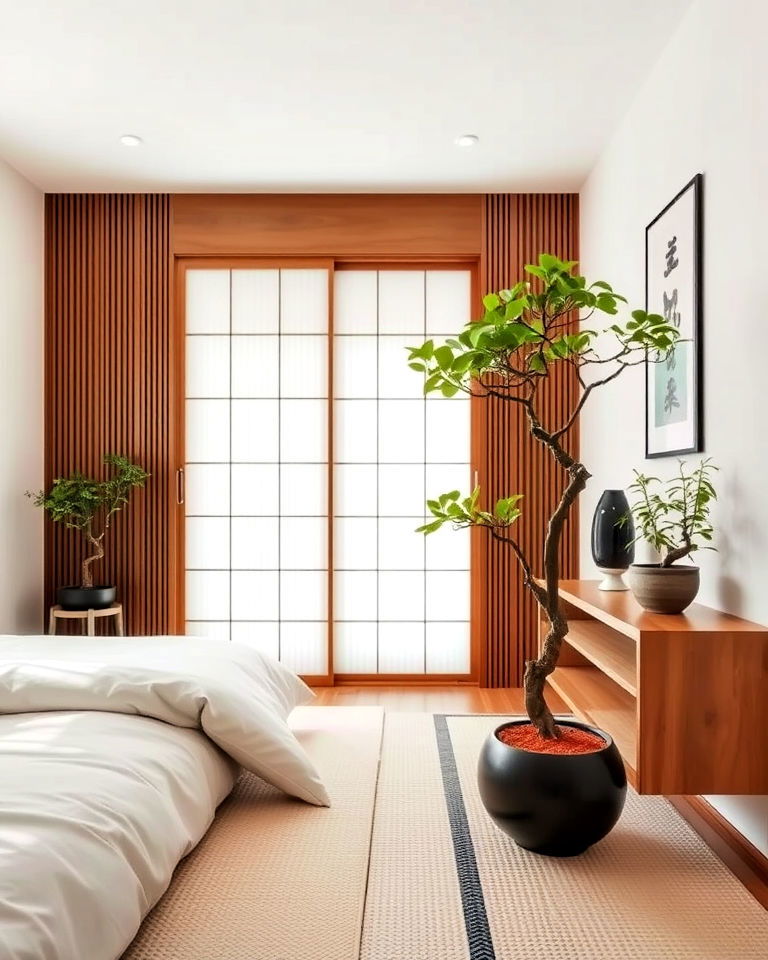
Transform your space with a Japanese-inspired bedroom featuring natural materials and clean lines. Bringing nature indoors is an integral aspect of Japanese design, and adding potted plants like bonsai or bamboo enhances the serene atmosphere of the bedroom. Indoor plants purify the air while reinforcing a connection to the natural world. Opt for minimalistic pots and keep the plant selection simple to maintain the room's clean aesthetic.
9. Include Wabi-Sabi Elements
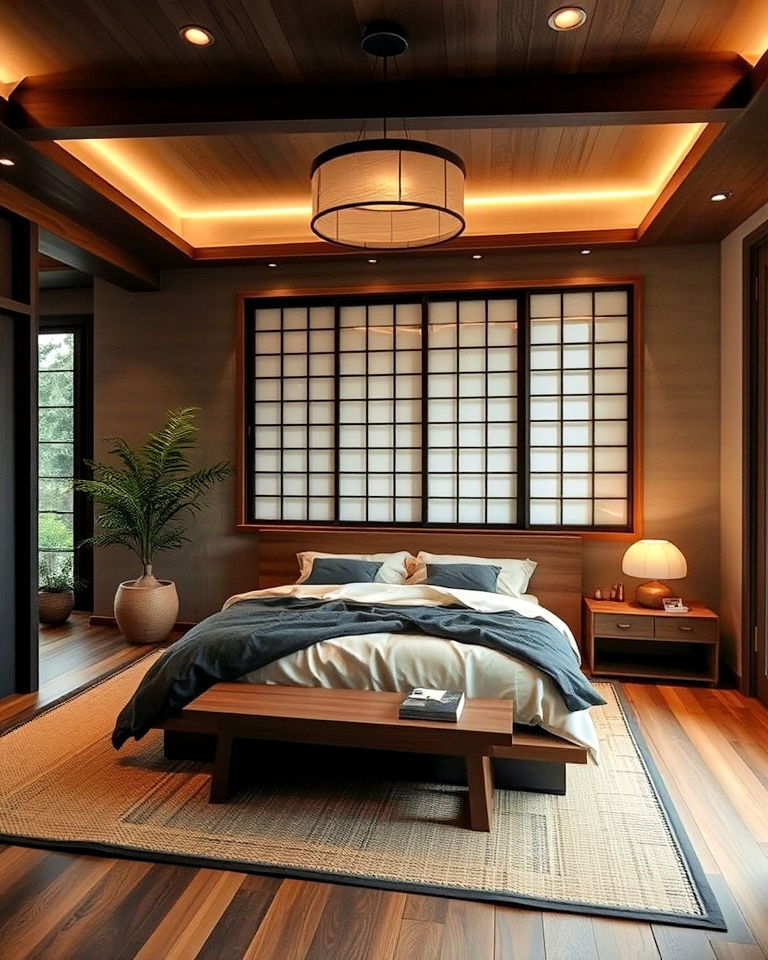
Wabi-sabi, the Japanese art of embracing imperfection, can be introduced through weathered furniture, textured fabrics, or handmade ceramics. These items reflect the beauty in imperfection and the passage of time, adding character to the space. Wabi-sabi promotes a lived-in feel, making the bedroom feel warm and personal without being overly polished.
10. Hang Scroll Art for Cultural Flair
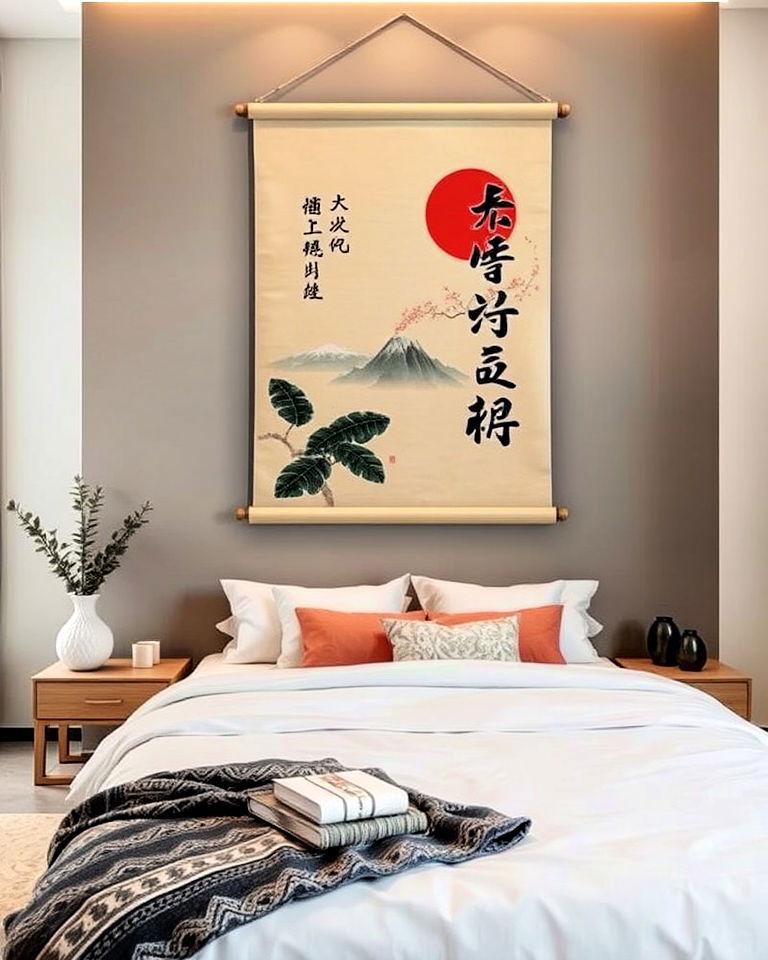
Adding scroll art to your bedroom introduces traditional Japanese artistry and culture. Hanging scrolls often feature nature scenes, calligraphy, or minimalist illustrations, and their vertical form adds a sense of height to the room. Choose designs with calming, nature-inspired themes to maintain the serene atmosphere typical of Japanese interiors.
11. Maximize Natural Light
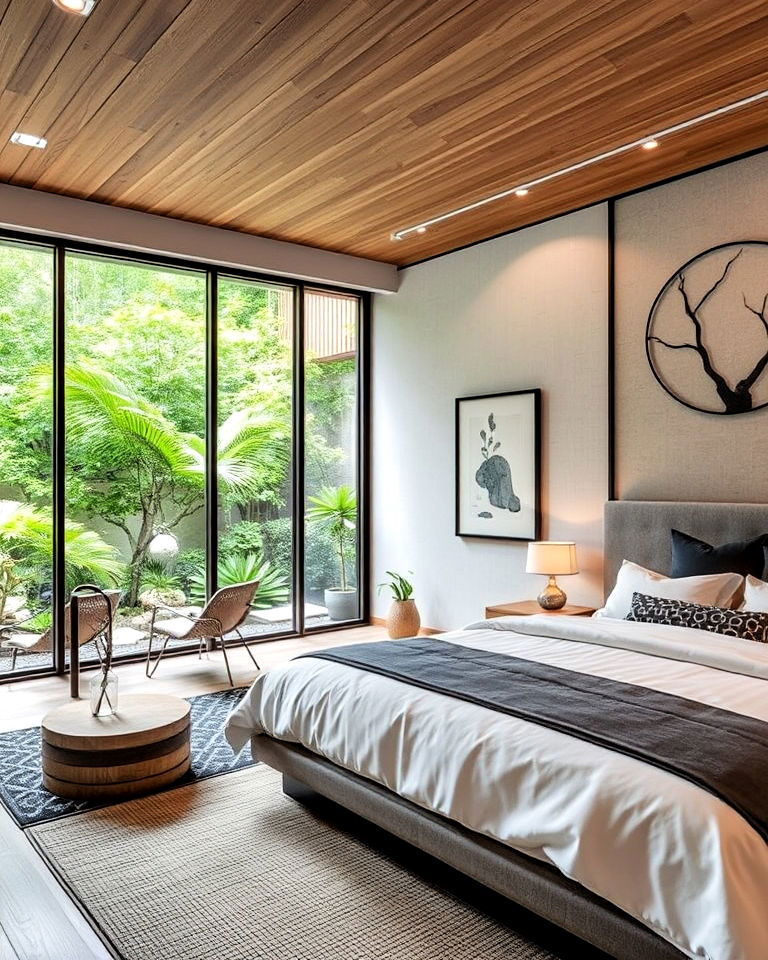
Natural light plays a key role in Japanese bedroom design, creating an open and airy feel. Large windows or strategically placed skylights can flood the room with sunlight, enhancing the minimalist aesthetic. To maintain privacy while allowing light to enter, consider using light-colored curtains or bamboo blinds, which blend seamlessly into the natural design.
12. Introduce a Zen Garden Element
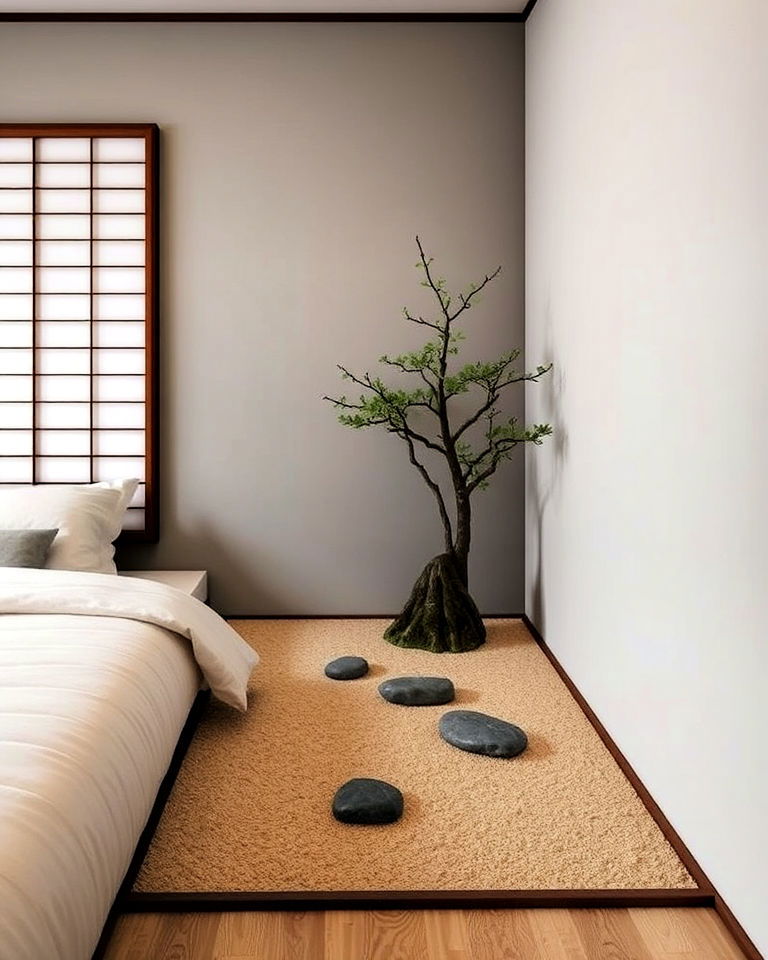
A small, indoor zen garden can be a calming focal point in a Japanese-style bedroom. Featuring smooth stones, raked sand, and perhaps a small bonsai tree, this addition encourages mindfulness and relaxation. The simplicity of a zen garden reinforces the minimalist and peaceful nature of the room, offering a space for meditation or quiet reflection.
13. Utilize Built-in Storage for Clutter-free Spaces
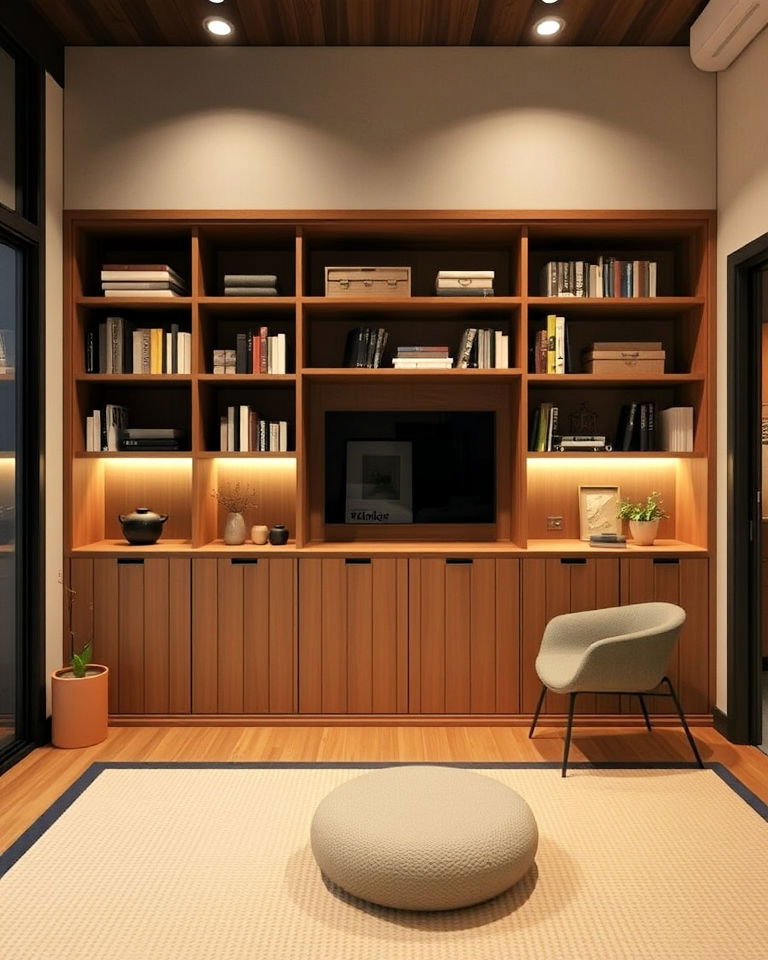
Discover serene Japanese bedroom design elements to create a calming, balanced sanctuary. To maintain the clean, minimalist lines of a Japanese bedroom, built-in storage is essential. Consider incorporating under-bed drawers or wall-mounted shelving to keep belongings out of sight. Hidden storage solutions reduce visual clutter and help create a calm, organized environment that’s key to Japanese interiors.
14. Use Bamboo Decor for an Eco-Friendly Touch
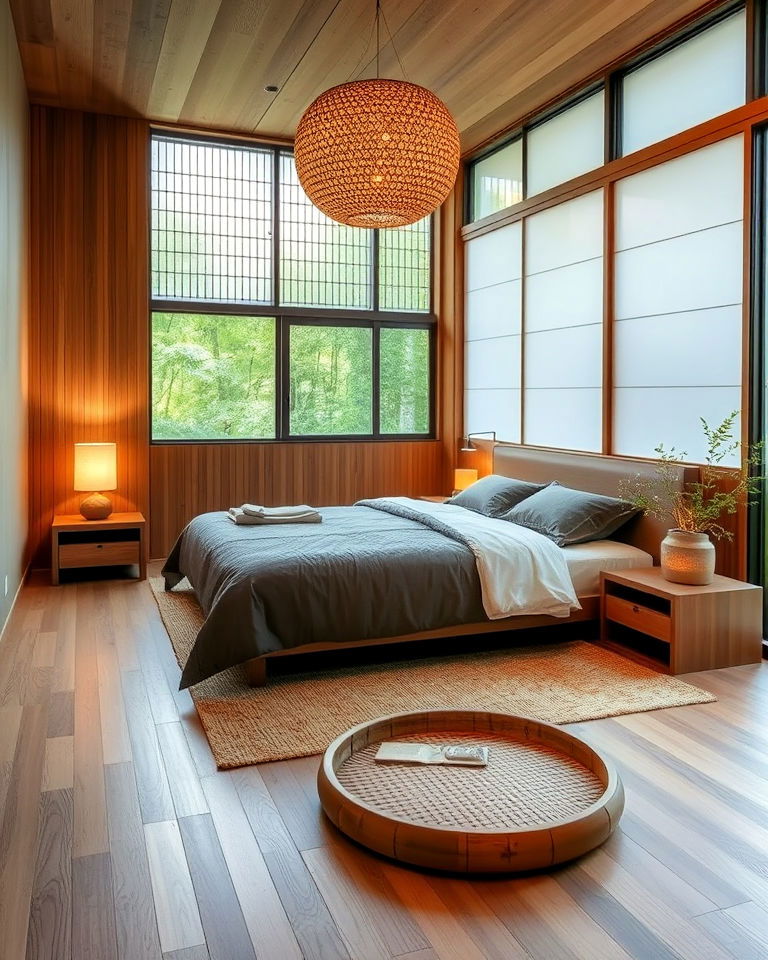
Bamboo is a versatile and eco-friendly material often used in Japanese design. From bamboo flooring to decorative accents like blinds or furniture, this sustainable material adds a natural element to the bedroom. Its light, airy appearance complements minimalist designs while reinforcing the connection to nature that is central to Japanese interiors.
15. Place Floor Cushions for Authentic Seating
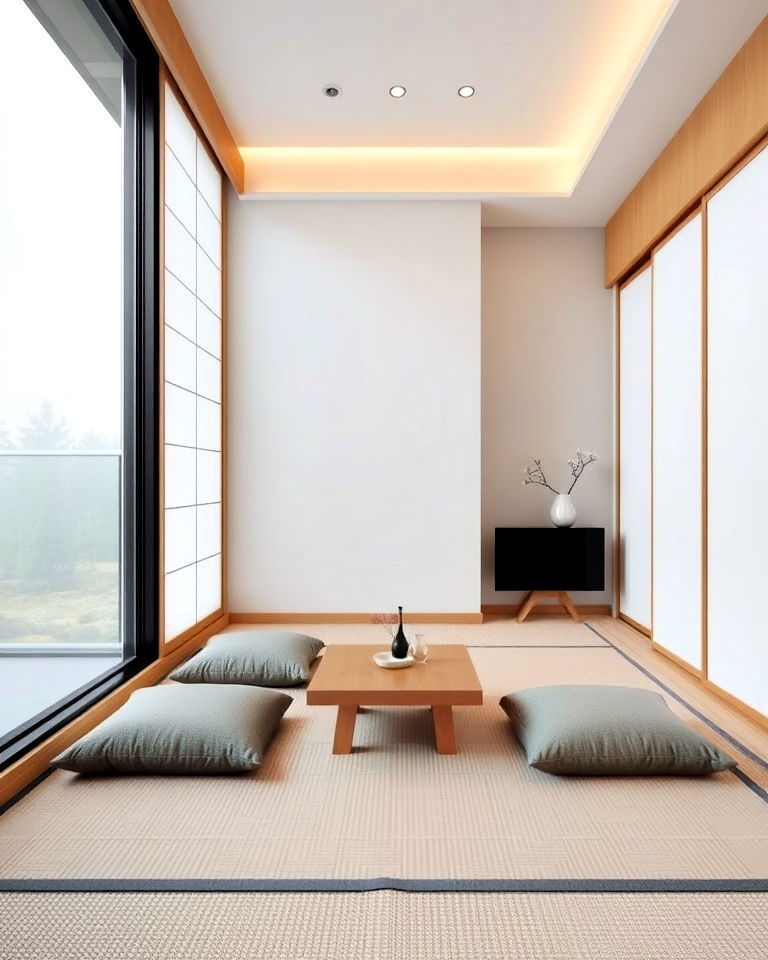
Floor cushions, or zabuton, provide authentic and functional seating in a Japanese bedroom. These cushions encourage relaxation at floor level and can be used for casual seating near a low table or for meditation. Their simplicity enhances the overall minimalist look, while adding comfort and softness to the room.
16. Layer Textures with Linen and Cotton
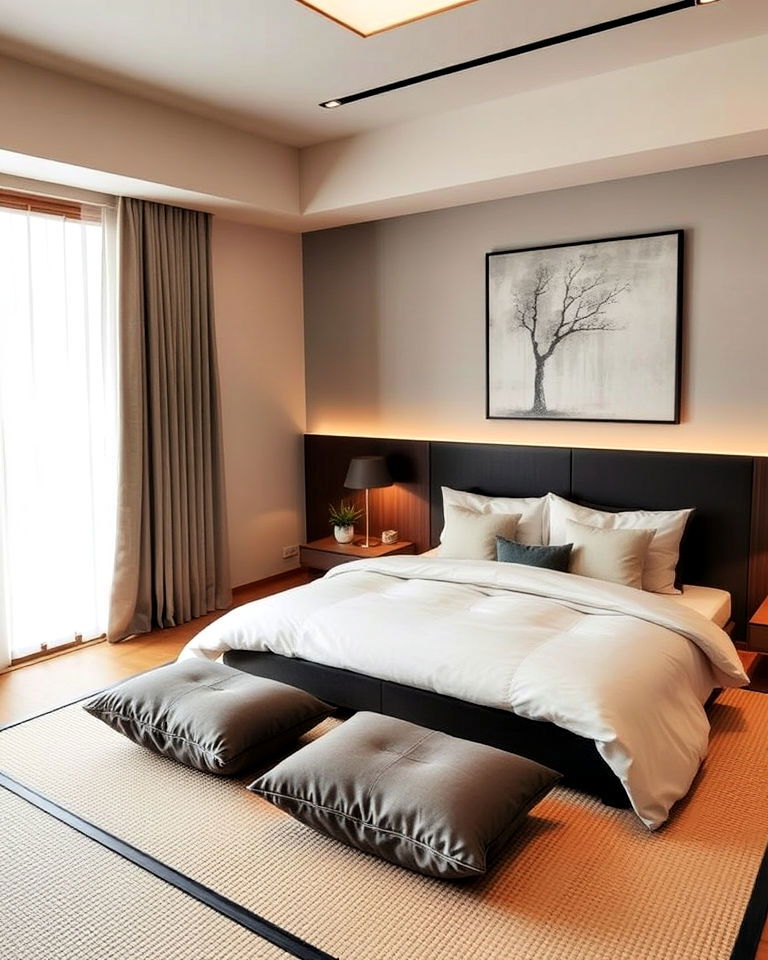
Incorporating soft, natural textiles like linen and cotton creates a cozy atmosphere without overwhelming the minimalist aesthetic. These materials provide a subtle texture that enhances the room's warmth and comfort. Opt for bedding, curtains, or throws in muted tones to maintain the calm, neutral color palette typical of Japanese design.
17. Add a Futon for Versatile Sleeping Arrangements
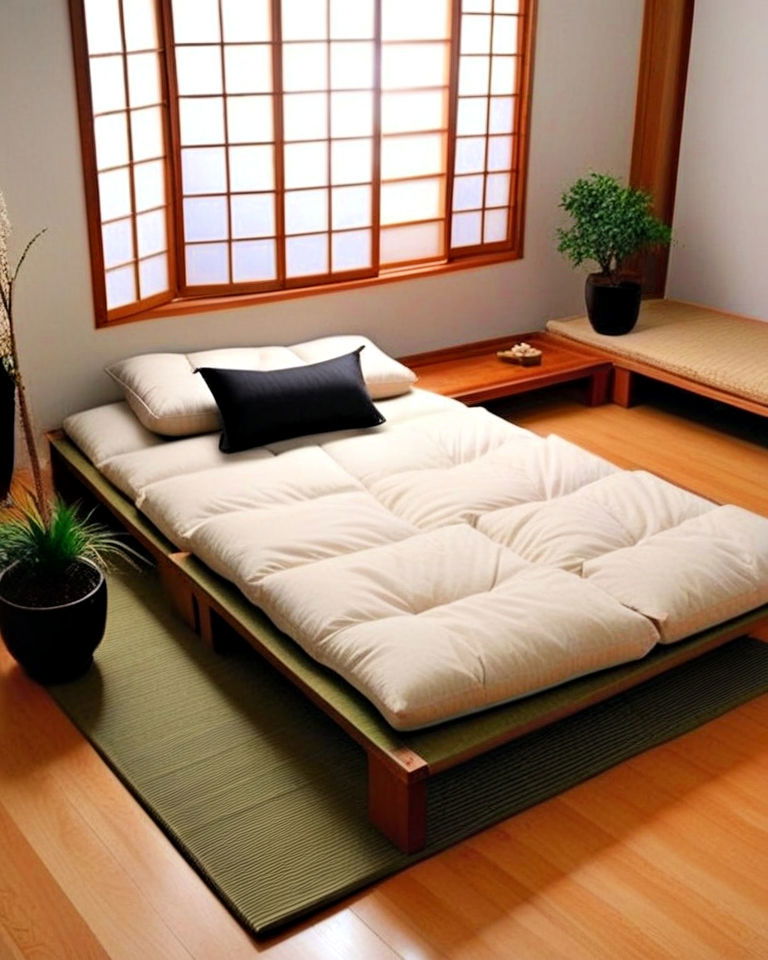
A traditional Japanese futon offers a flexible and space-saving sleeping option. Unlike Western beds, a futon can be easily rolled up and stored during the day, freeing up valuable floor space. This practical solution aligns with the minimalist principles of Japanese design, making the room feel open and uncluttered while preserving comfort.
18. Include Stone Accents for Earthy Vibes

Get inspired by elegant Japanese bedroom ideas that bring simplicity and peace to your home. Stone elements, such as a bedside table, decorative bowl, or small sculptures, add a grounding, earthy feel to the bedroom. These natural accents bring the outdoors inside, complementing the wood and plant elements often found in Japanese interiors. Stone’s raw texture contrasts with the softer materials in the room, creating a balanced and serene environment.
19. Incorporate Calligraphy Art for Elegance
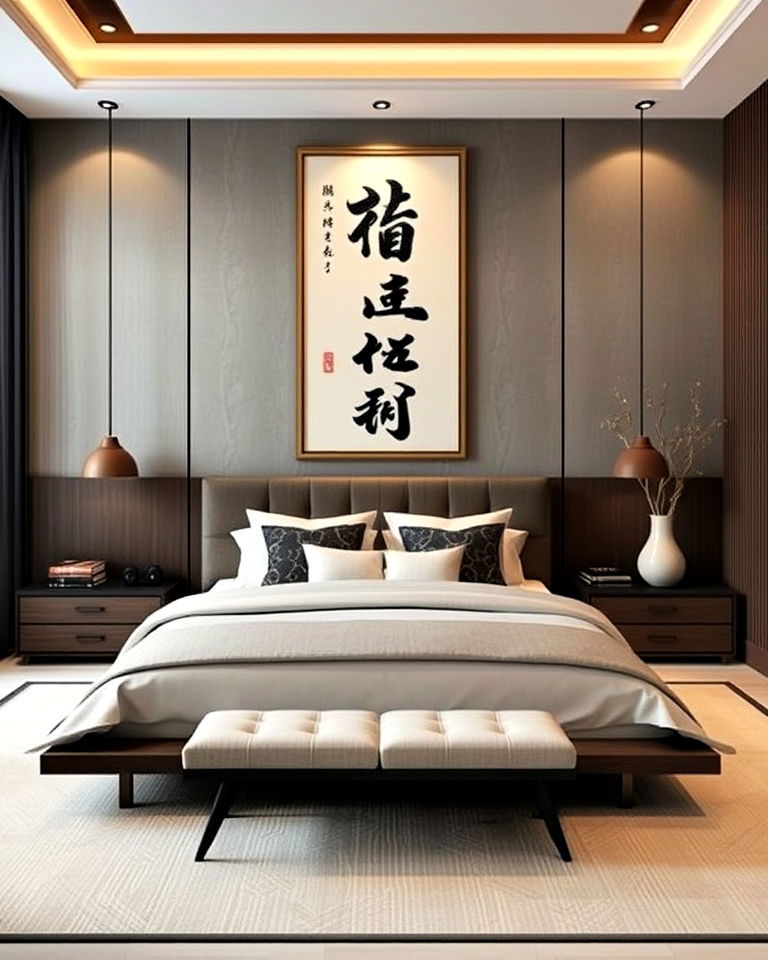
Calligraphy, an art form deeply rooted in Japanese culture, can be introduced into your bedroom through framed artwork or wall hangings. These elegant, flowing characters often feature inspirational words or phrases, adding a personal and cultural touch. The minimalist style of calligraphy complements the clean lines of Japanese interiors, enhancing the room's peaceful atmosphere.
20. Choose Paper Lanterns for Ambient Lighting
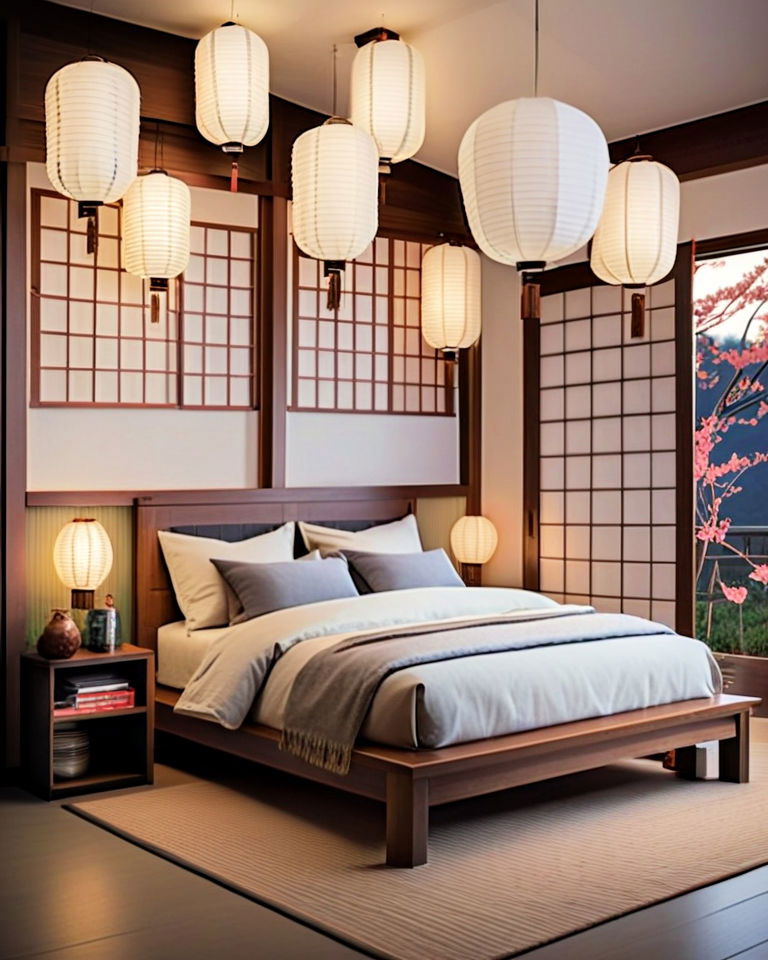
Paper lanterns, with their soft, diffused light, create a warm and tranquil atmosphere in a Japanese-style bedroom. Their simple yet elegant design adds a traditional touch while providing ambient lighting that complements the room's natural elements. Whether hung from the ceiling or placed on a bedside table, paper lanterns enhance the serene and cozy vibe.
21. Install Bamboo Blinds for Natural Light Control
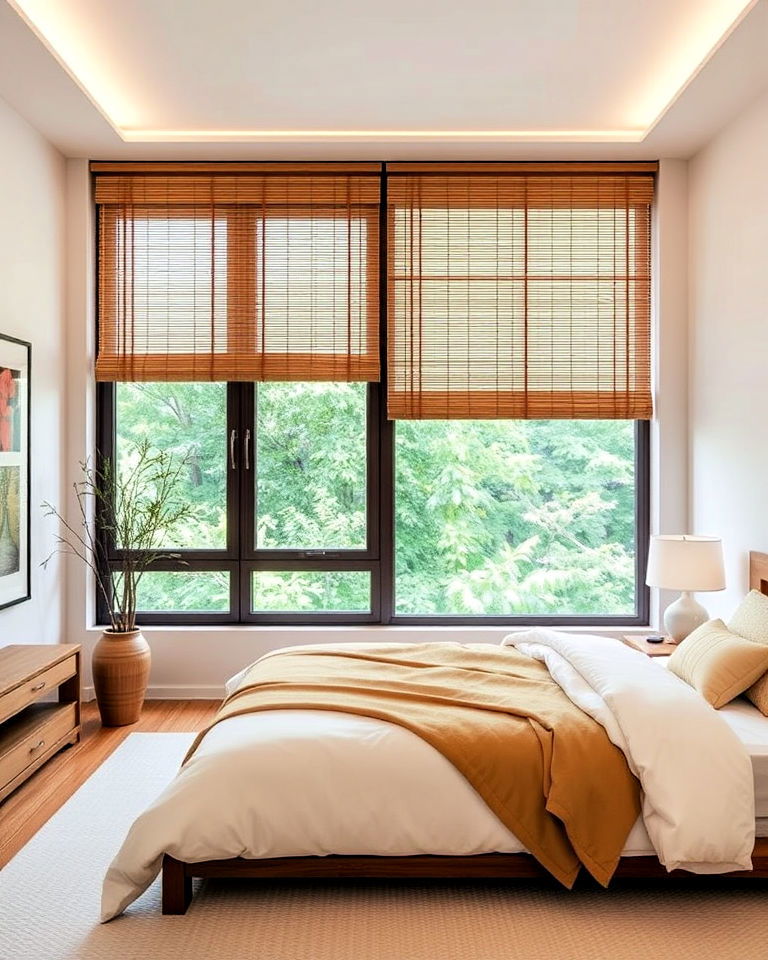
Bamboo blinds offer a natural and functional way to control light in a Japanese-inspired bedroom. Their organic texture complements wooden furniture and tatami mats, while their light-filtering properties allow for privacy without blocking out sunlight. These blinds align with the minimalist aesthetic, emphasizing simplicity and a connection to nature.
22. Incorporate Zen Color Schemes
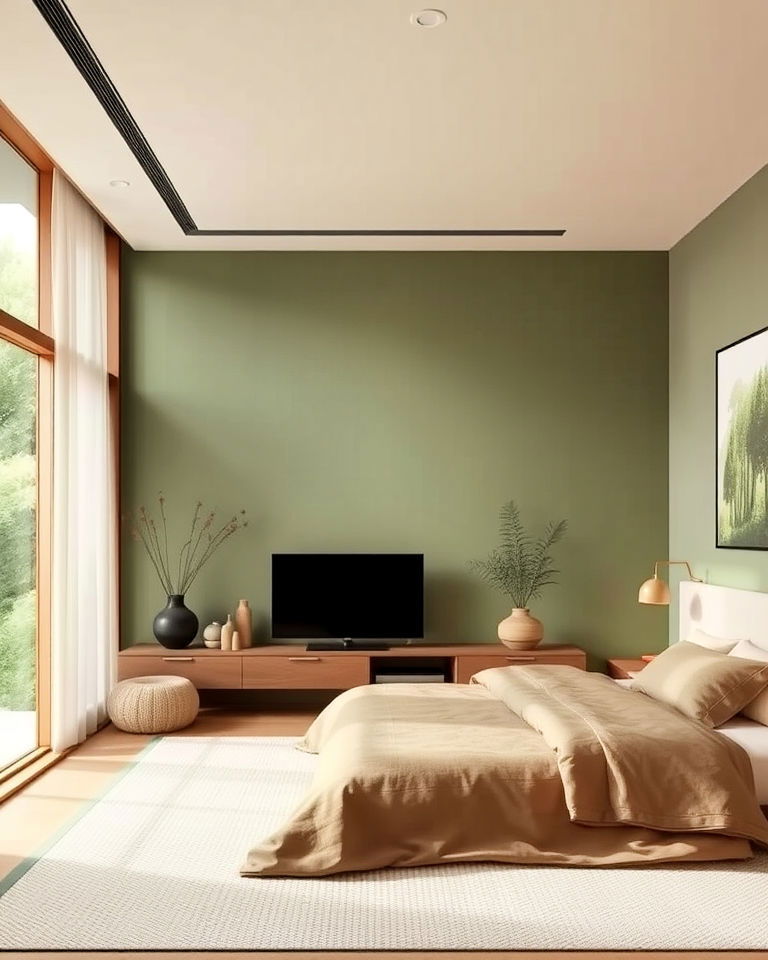
Zen-inspired color schemes often draw from nature, with shades of green, brown, and beige creating a calming environment. These colors help establish a sense of balance and harmony in the room, essential to the Zen philosophy. Soft greens mimic the tranquility of a forest, while earthy browns ground the space, reinforcing the natural connection central to Japanese design.
23. Use Stone or Gravel Flooring for a Natural Feel
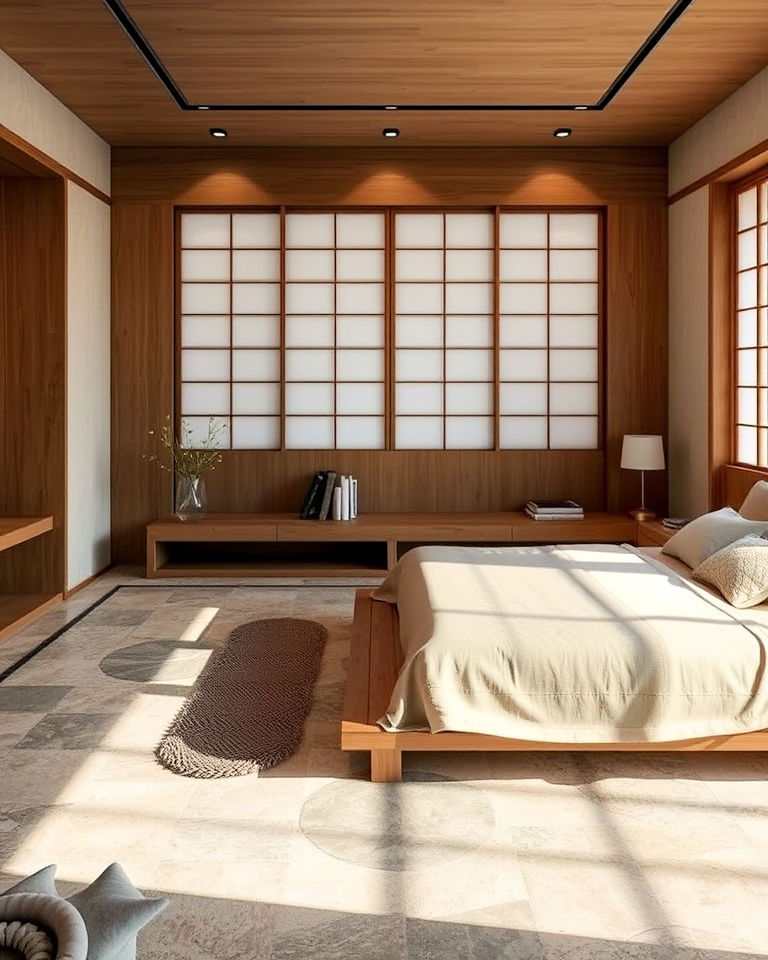
For a bold design choice, consider incorporating stone or gravel flooring into your bedroom. While unconventional, this tactile and organic material can evoke a zen garden feel, bringing an earthy, natural element indoors. If full stone flooring seems too extreme, use a small section, perhaps near an indoor garden or decorative corner, to emphasize nature.
24. Add a Bonsai Tree for a Touch of Artistry
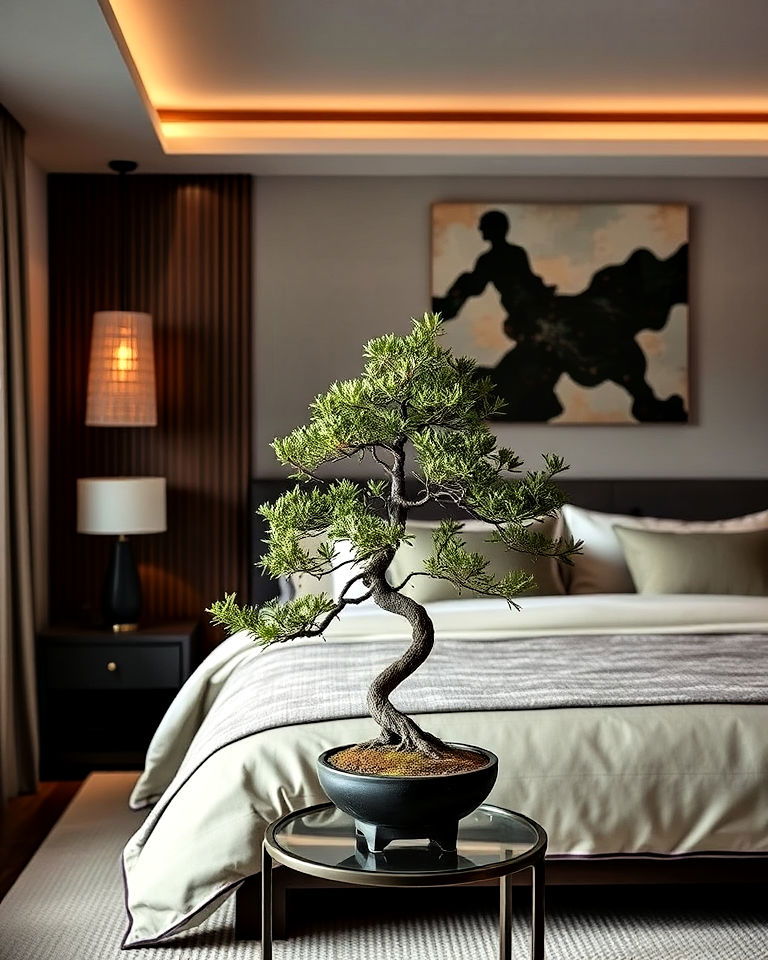
Elevate your space with Japanese bedroom decor for a Zen-like atmosphere. Bonsai trees offer a living, artistic focal point in a Japanese-style bedroom. These carefully cultivated miniature trees symbolize patience, balance, and harmony, aligning with the principles of Japanese design. A bonsai can be placed on a windowsill or small table, where its simple beauty adds a serene, natural element to the space.
25. Choose Organic Bedding Materials
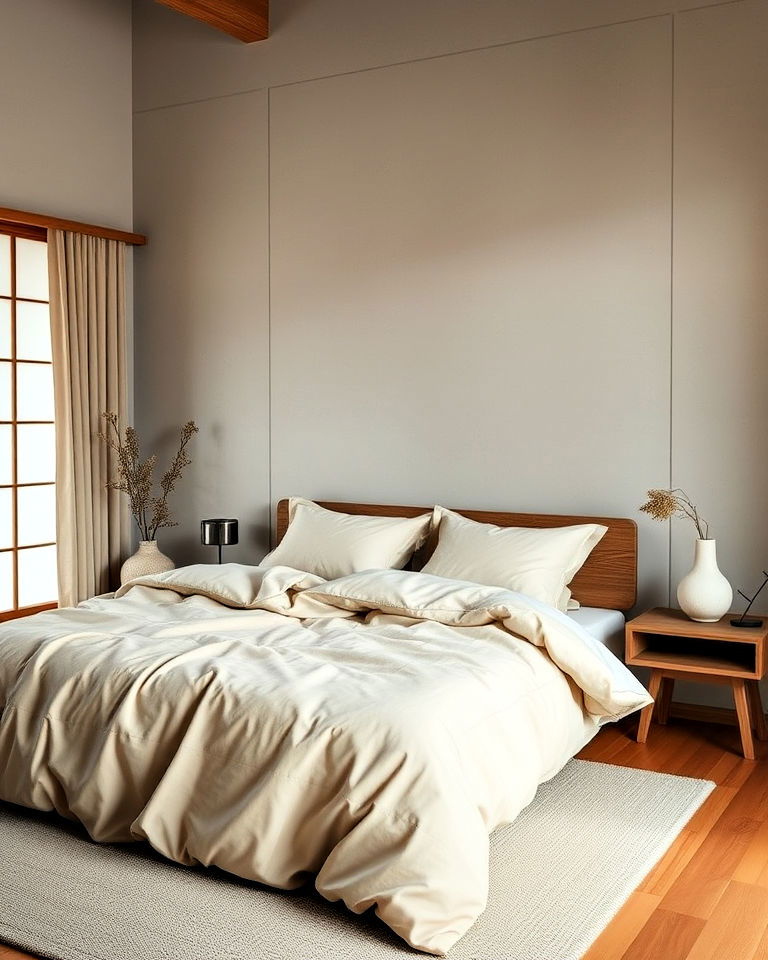
In keeping with the emphasis on nature, choose bedding made from organic materials such as cotton, hemp, or linen. These fabrics are not only eco-friendly but also provide a soft, breathable texture that enhances comfort. Their neutral, earthy tones complement the room’s minimalist aesthetic while promoting a healthy, chemical-free environment for rest.
26. Integrate a Water Feature for Tranquility
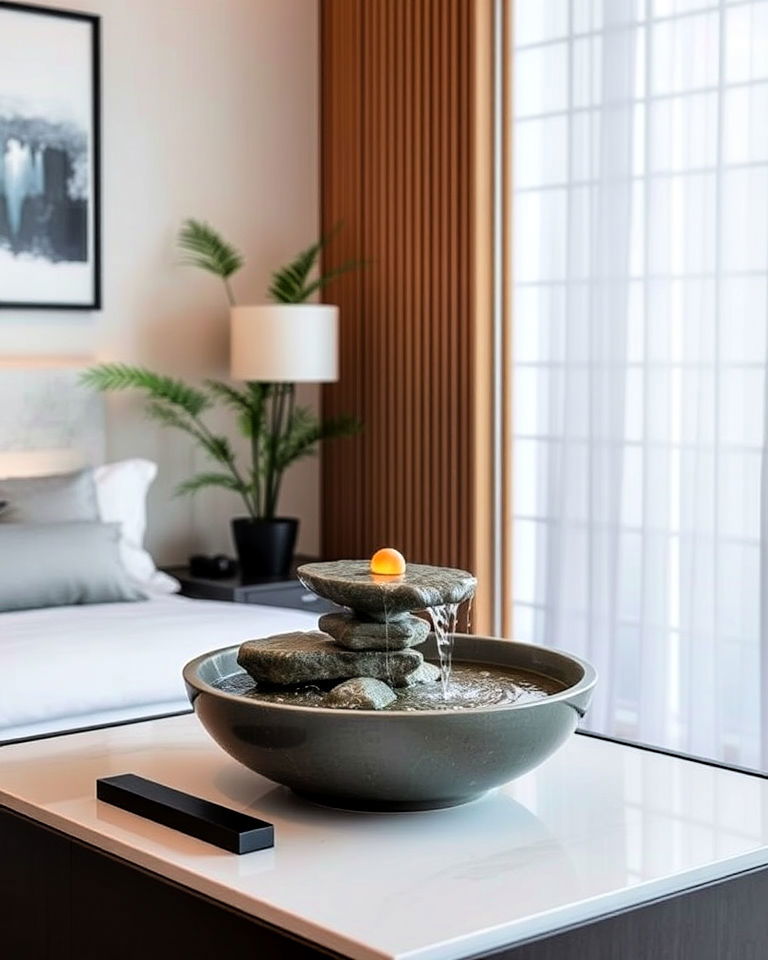
A small indoor water feature, such as a tabletop fountain, can add a soothing element to your Japanese bedroom. The sound of trickling water creates a relaxing ambiance, helping to reduce stress and promote sleep. This natural feature reinforces the room's connection to the outdoors while maintaining the minimalist design that defines Japanese interiors.
27. Utilize Open Spaces for a Zen Layout
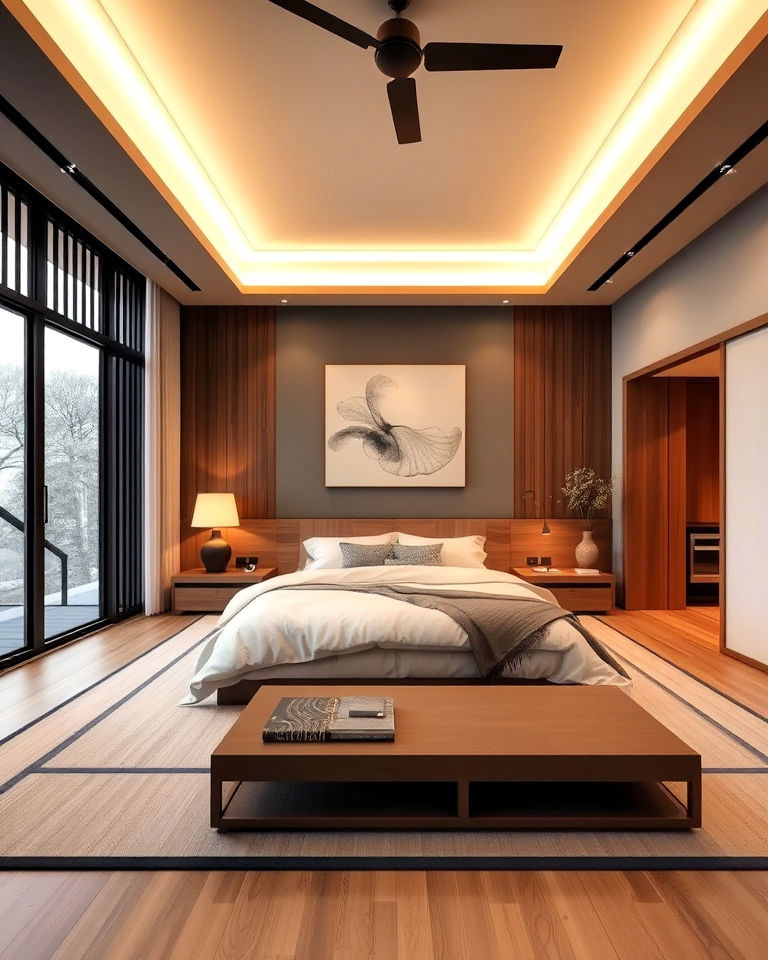
Open floor space is a defining feature of Japanese bedroom design, creating a sense of calm and freedom. Avoid overcrowding the room with unnecessary furniture or décor, and instead focus on a few essential pieces. This allows for better flow and movement, aligning with the Zen principle of simplicity and mindfulness in daily living.
28. Opt for Sliding Wardrobe Doors

Sliding wardrobe doors, similar to traditional fusuma, provide a sleek and space-efficient storage solution. These doors can be finished in natural wood or neutral tones to blend seamlessly with the room's design. By hiding storage behind sliding panels, you maintain the clean, uncluttered look essential to Japanese interiors.
29. Add Stone Pebble Accents
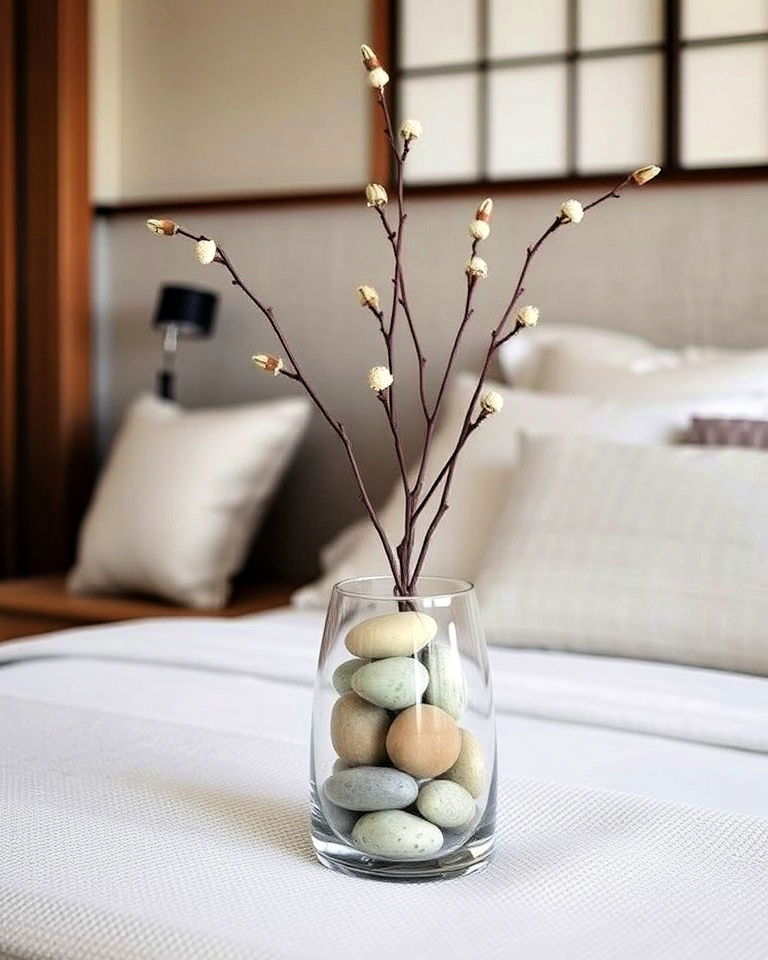
Explore beautiful Japanese bedrooms that showcase timeless elegance and simplicity. Stone pebbles, whether used in a decorative vase, a zen garden, or as part of a small indoor water feature, add an earthy and natural element to the bedroom. Their smooth, organic texture contrasts with softer fabrics and materials, creating a balanced, harmonious space. These small accents help reinforce the connection to nature central to Japanese design.
30. Keep Décor Minimal for Peace of Mind
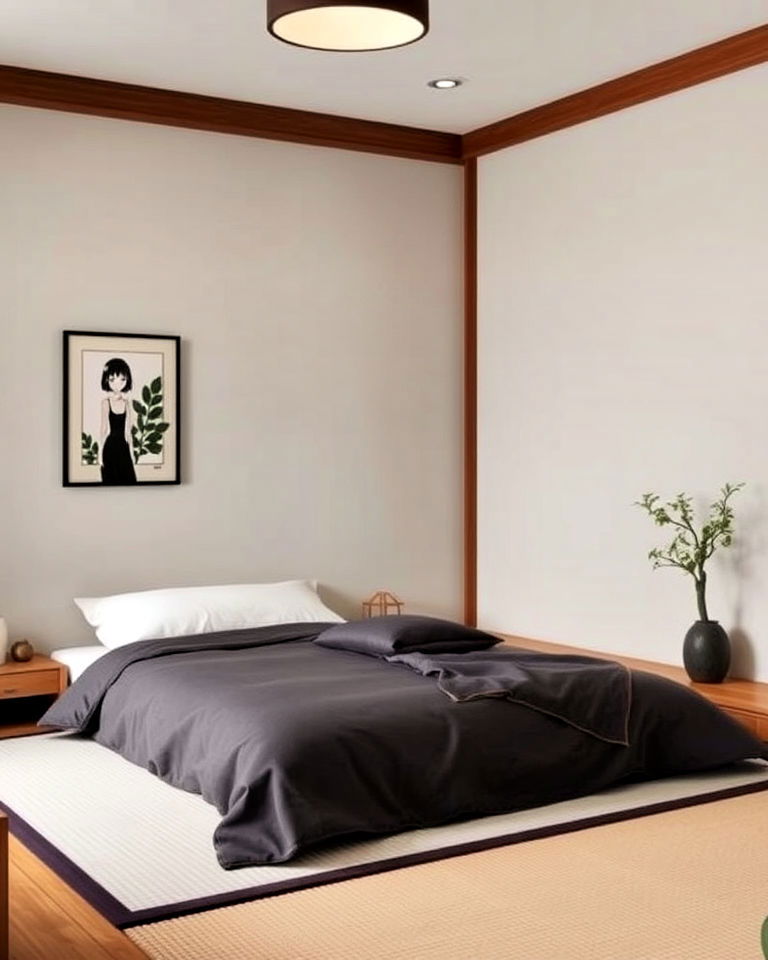
Above all, Japanese bedroom design is about simplicity and mindfulness. Keeping décor to a minimum helps foster a peaceful environment, free from distractions. Choose a few meaningful items, such as a single piece of artwork or a bonsai tree, and avoid over-accessorizing. This minimalism not only enhances the room’s visual appeal but also promotes relaxation and mental clarity.
Conclusion:
Incorporating Japanese bedroom design ideas into your home can elevate both your space and your well-being. By emphasizing simplicity, natural materials, and functionality, these design elements create an atmosphere of tranquility and balance. Using neutral color palettes, low furniture, and eco-friendly accents like bamboo or indoor plants, you can achieve a serene, clutter-free environment that promotes relaxation. Embracing these design principles not only transforms your bedroom into a peaceful haven but also enhances the connection between your living space and the natural world.
Key Points:
- Minimalism and Simplicity: Japanese bedroom design revolves around clutter-free spaces, focusing on clean lines and essential furniture.
- Natural Materials: The use of wood, stone, bamboo, and organic fabrics creates a warm and inviting atmosphere.
- Low-Profile Furniture: Low beds, futons, and floor cushions foster a closer connection to the earth, enhancing the room's tranquility.
- Soft, Neutral Color Palettes: Calming tones like beige, gray, and natural wood shades are integral to Japanese design, promoting relaxation.
- Harmony with Nature: Incorporating elements like indoor plants, natural light, and water features strengthens the connection to the outdoors.
- Shoji Screens and Sliding Doors: These space-saving features offer privacy while maintaining an open, airy feel.
- Wabi-Sabi Philosophy: Embracing imperfection through weathered textures and natural flaws adds character and depth to the design.
What to Do Next:
- Simplify your color palette to neutral tones to create a more calming environment.
- Evaluate your current bedroom to identify opportunities for incorporating minimalist design elements and natural materials.
- Introduce low-profile furniture like a futon or platform bed for a grounded, serene feel.
- Add natural elements such as wood, bamboo, or indoor plants to enhance the space's connection to nature.
- Consider installing sliding doors or shoji screens for a space-saving, authentic touch.

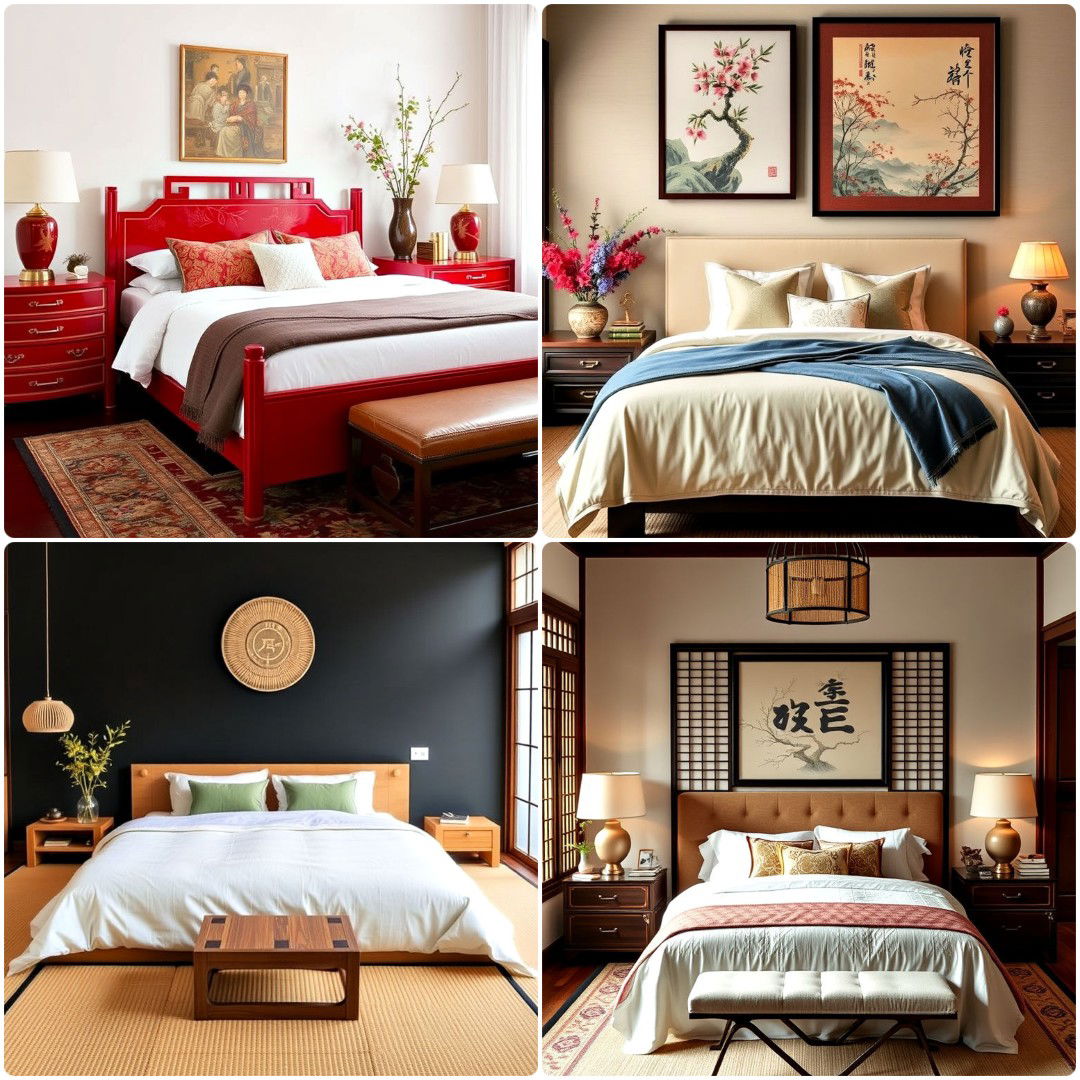


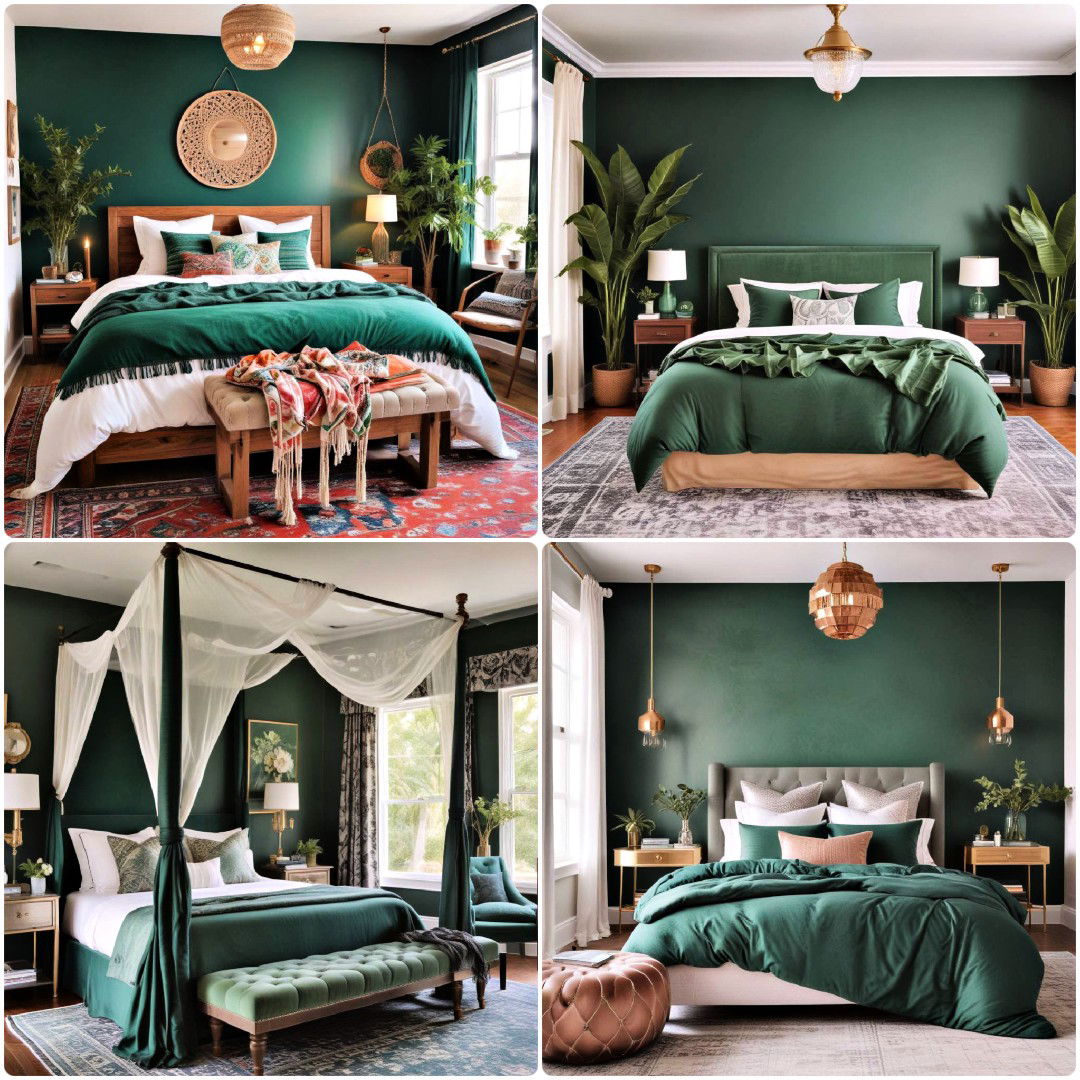
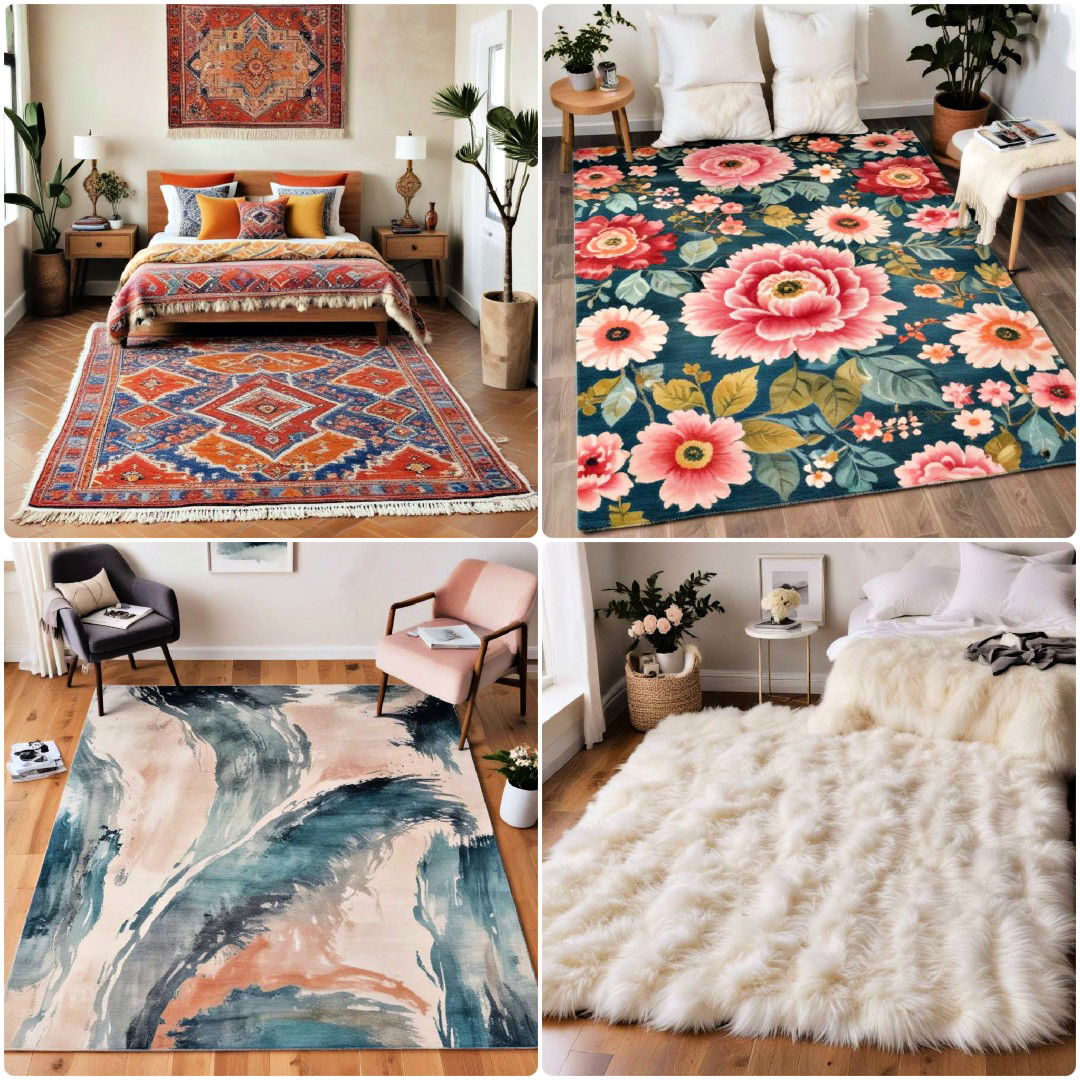


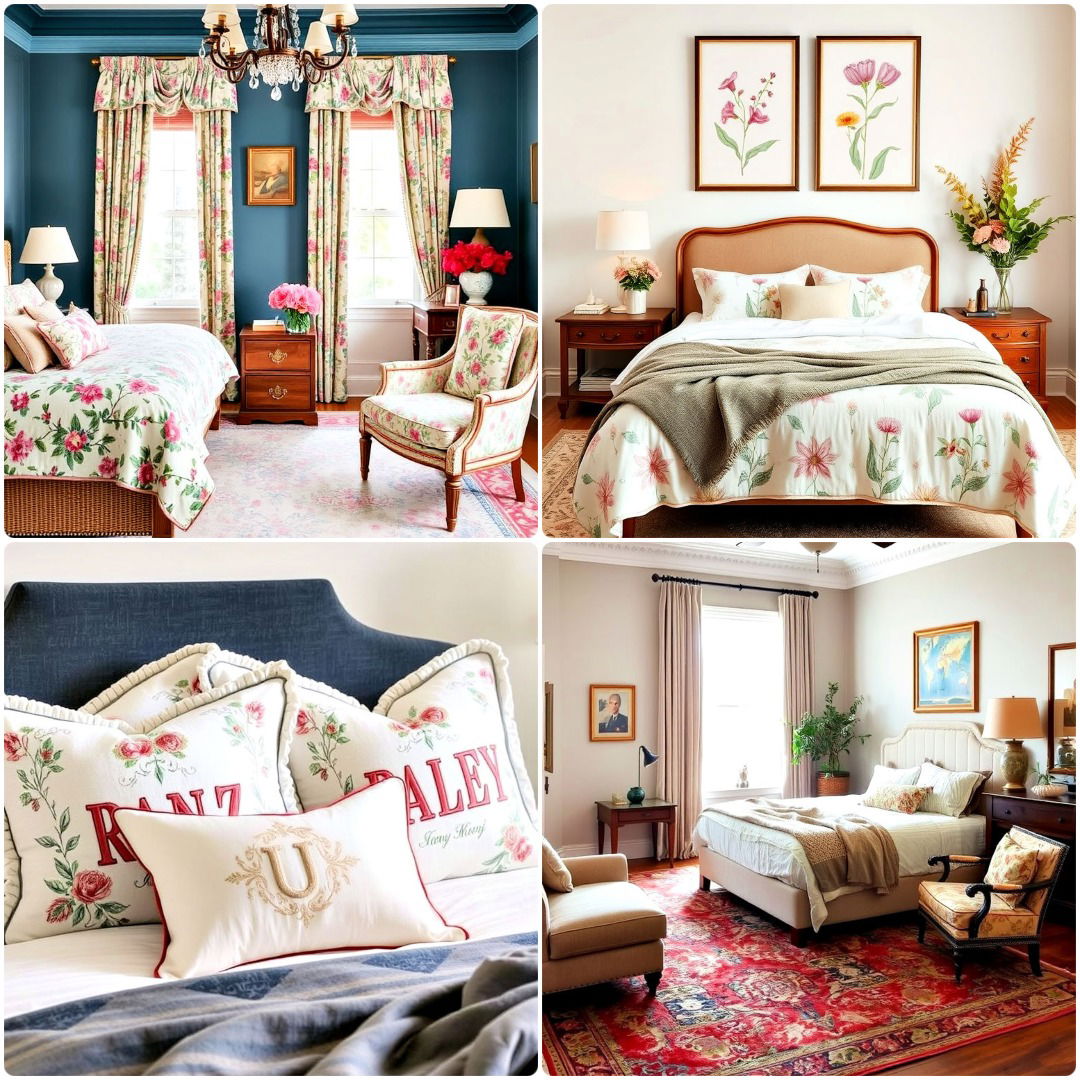
Leave a Reply